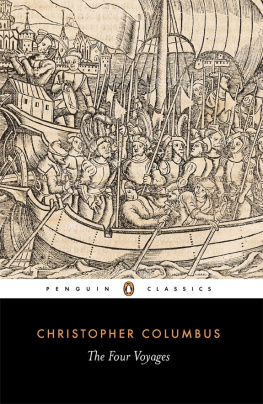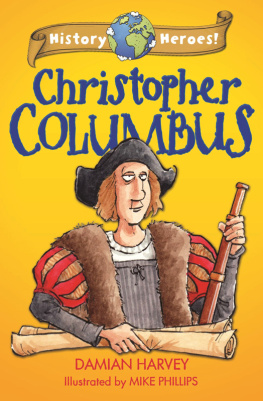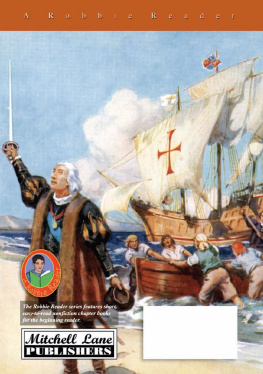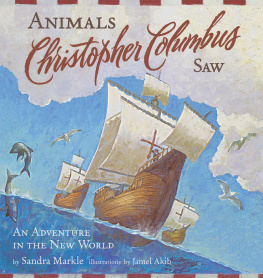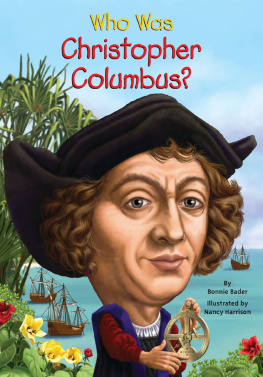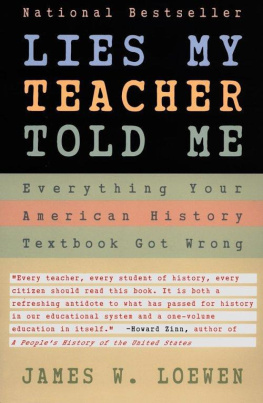Christopher Columbus - The Four Voyages
Here you can read online Christopher Columbus - The Four Voyages full text of the book (entire story) in english for free. Download pdf and epub, get meaning, cover and reviews about this ebook. year: 1969, publisher: Penguin, genre: Non-fiction / History. Description of the work, (preface) as well as reviews are available. Best literature library LitArk.com created for fans of good reading and offers a wide selection of genres:
Romance novel
Science fiction
Adventure
Detective
Science
History
Home and family
Prose
Art
Politics
Computer
Non-fiction
Religion
Business
Children
Humor
Choose a favorite category and find really read worthwhile books. Enjoy immersion in the world of imagination, feel the emotions of the characters or learn something new for yourself, make an fascinating discovery.
- Book:The Four Voyages
- Author:
- Publisher:Penguin
- Genre:
- Year:1969
- Rating:3 / 5
- Favourites:Add to favourites
- Your mark:
- 60
- 1
- 2
- 3
- 4
- 5
The Four Voyages: summary, description and annotation
We offer to read an annotation, description, summary or preface (depends on what the author of the book "The Four Voyages" wrote himself). If you haven't found the necessary information about the book — write in the comments, we will try to find it.
The Four Voyages — read online for free the complete book (whole text) full work
Below is the text of the book, divided by pages. System saving the place of the last page read, allows you to conveniently read the book "The Four Voyages" online for free, without having to search again every time where you left off. Put a bookmark, and you can go to the page where you finished reading at any time.
Font size:
Interval:
Bookmark:

THE FOUR VOYAGES OF CHRISTOPHER COLUMBUS
J. M. COHEN, born in London in 1903 and a Cambridge graduate, was the translator of many volumes for the Penguin Classics, including versions of Cervantes, Rabelais and Montaigne. For some years he assisted E. V. Rieu in editing the Penguin Classics. He collected the three books of Comic and Curious Verse and anthologies of Latin American and Cuban writing. With his son Mark Cohen he also edited the Penguin Dictionary of Quotations and the two editions of its companion Dictionary of Modern Quotations. He frequently visited Spain and made several visits to Mexico, Cuba and other Spanish American countries.
J. M. Cohen died in 1989. The Times obituary described him as the last great English men of letters, while the Independent wrote that his influence will be felt for generations to come.
Being his own log-book, letters and
dispatches with connecting narrative drawn
from the Life of the Admiral by his
son Hernando Colon and other
contemporary historians
EDITED AND TRANSLATED BY
J. M. COHEN

PENGUIN BOOKS
PENGUIN BOOKS
Published by the Penguin Group
Penguin Books Ltd, 80 Strand, London WC2R 0RL, England
Penguin Putnam Inc., 375 Hudson Street, New York, New York 10014, USA
Penguin Books Australia Ltd, 250 Camberwell Road, Camberwell, Victoria 3124, Australia
Penguin Books Canada Ltd, 10 Alcorn Avenue, Toronto, Ontario, Canada M4V 3B2
Penguin Books India (P) Ltd, 11 Community Centre, Panchsheel Park, New Delhi - 110 017, India
Penguin Books (NZ) Ltd, Cm Rosedale and Airborne Roads, Albany, Auckland, New Zealand
Penguin Books (South Africa) (Pty) Ltd, 24 Sturdee Avenue, Rosebank 2196, South Africa
Penguin Books Ltd, Registered Offices: 80 Strand, London WC2R 0RL, England
www.penguin.com
This translation first published 1969
21
Copyright J. M. Cohen, 1969
All rights reserved
Except in the United States of America, this book is sold subject to the condition that it shall not, by way of trade or otherwise, be lent, re-sold, hired out, or otherwise circulated without the publishers prior consent in any form of binding or cover other than that in which it is published and without a similar condition including this condition being imposed on the subsequent purchaser
9780141920429
To Mark
who suggested the subject and gave me
most generous help
with the book
CHRISTOPHER COLUMBUSs four voyages of discovery to the New World were recorded in a number of letters and dispatches written by him and the officers who sailed with him. The story was taken up by a talented writer of newsletters to the great, Peter Martyr, and later by the royal historian Captain Gonzalo Fernandez de Oviedo and by Fray Bartolom de las Casas, in particular, both of whom knew the Indies, and by Columbuss own son Hernando, who accompanied his father on his fourth voyage and wrote his biography. A great library of documents was collected in the Casa de las Indias at Seville (where American affairs were initially handled) and afterwards taken to Hispaniola, and in addition Hernando himself had many papers which were read also by Bartolom de las Casas, who was a friend of the Columbus family. During the litigation concerning that familys claims to wealth and governorship, facts were discussed and interpreted in a variety of ways. When Oviedo published his official Historia general y natural de las Indias in 1547 - fifty-six years after Columbuss landfall - it might have seemed that everything relevant to the voyages had been read and written.
It was not until the quatercentenary of 1892, which inspired a number of books and articles on the man and his discovery, that Christopher Columbus emerged as a mysterious figure about whom many cardinal questions can be asked and few conclusively answered.
Oviedo, with whose narrative this book begins, accepted Columbus as a Genoese of no great lineage, education or attainments, one who had sailed on various commercial voyages, and who conceived and tirelessly advocated from court to court a scheme for crossing the ocean from Spain to China and opening up a direct trade route to the west, by which the gold, jewels and spices of the Orient could be brought to the ports of Castile: a reasonable trading venture, which he made more attractive to the Catholic sovereigns Ferdinand and Isabela, by offering them the prospect that the inhabitants of the intervening lands, perhaps of China and Japan themselves, might be converted to Christianity on the way. The royal pair were enthusiasts for the conversion of Jews and Moslems, and Columbus carried on his first voyage a converted Jew with a knowledge of Arabic, who would be able to expound the Christian mysteries to the Chinese, Japanese and Indians, who were presumed to speak Arabic.
Oviedo, as the royal historian, takes care to refute Columbuss claims to having presented the sovereigns with a new world. This so-called new world was already known to the ancients, and, as Oviedo tries to prove by a resort to legends which could surely have convinced nobody, had actually belonged to the earliest kings of Spain.
Oviedos legends are transparent nonsense. But they are no more foolish than most of the arguments which Columbus himself put forward when trying to find backers for his first voyage, and even when theorizing about the probable shape of the world just after the discovery of Trinidad on his third voyage. Ever since the time of the Greek cosmographers Marinus of Tyre and Ptolemy, there had been theories that the world was a sphere and that it would consequently be possible to go to the east by sailing west. Two things were in dispute: the distance, which could only be calculated by computing the circumference of the world at some given latitude; and whether or not there were lands or islands on the way. As for the distance, the shortest possibility was advanced by Marinus of Tyre, and this figure was accepted by Paolo Toscanelli of Florence, an aged cosmographer, who had been approached by the Portuguese and with whom Columbus had exchanged letters. Toscanelli thought Columbuss project feasible, but does not appear to have respected his learning. However, he sent him a map, which Columbus undoubtedly carried and consulted. Indeed, we find him discussing it with the captain of one of his caravels, Martin Alonso Pinzn, when he was already in the latitude of the Indies on his first voyage.
Columbuss theories were more rigid and even more optimistic than Toscanellis. He mentally fixed the distance between Portugal and Chipangu Qapan) at 2,760 miles. The actual distance is 12,000. We can no more accept Hernando Colons claim that his father was a man of education than that he was of noble descent.
In relation to the possible islands lying between Spain and China, of which he was granted the governorship by the Catholic sovereigns at Granada before his first voyage, Columbus was equally credulous. There were many stories of islands lying out in the Atlantic - Antilla, Brasil, St Brendans Isle - which were either pure inventions or sailors tales of cloud banks or ice-floes. In Ireland, the Azores, the Canaries and the Cape Verde Islands there were stories of lands to be seen on clear days to the west, but the only western lands that had been visited - Greenland, Labrador and Newfoundland, which had been colonized by the Vikings - were not mentioned in any of Columbuss letters or notes. The Danes, with a Portuguese pilot aboard, had actually revisited Labrador only fifteen years before he landed in the Bahamas. But having visited Iceland, on a trading voyage, Columbus had no interest in the discovery of more frozen wastes. His goal was the rich lands described by Marco Polo and the romantic Sir John Mandeville, lands flowing with gold and spices and eager to be awakened to the true faith.
Font size:
Interval:
Bookmark:
Similar books «The Four Voyages»
Look at similar books to The Four Voyages. We have selected literature similar in name and meaning in the hope of providing readers with more options to find new, interesting, not yet read works.
Discussion, reviews of the book The Four Voyages and just readers' own opinions. Leave your comments, write what you think about the work, its meaning or the main characters. Specify what exactly you liked and what you didn't like, and why you think so.

